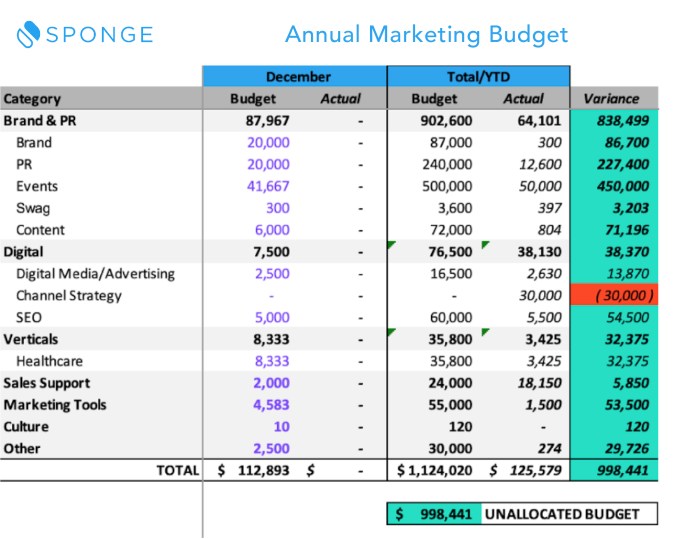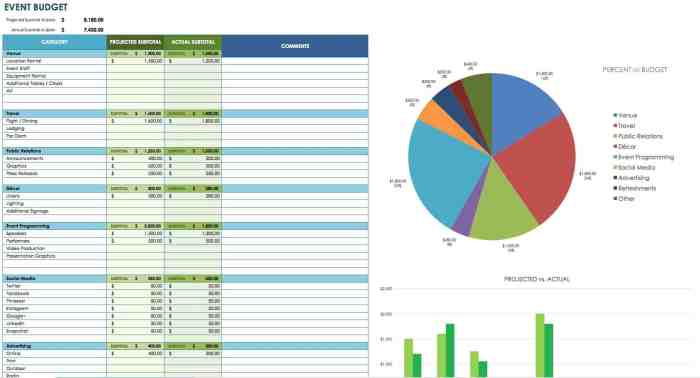Developing a Marketing Budget takes center stage, inviting readers into a world of financial prowess and strategic planning. From allocating funds to tracking performance, this guide dives deep into the essentials of marketing budgeting.
Importance of Developing a Marketing Budget

Having a marketing budget is crucial for businesses to effectively plan, execute, and measure the success of their marketing efforts. Without a defined budget, companies may struggle to allocate resources efficiently and may miss out on valuable opportunities to reach their target audience.
A well-planned marketing budget can have a significant impact on marketing strategies by allowing businesses to:
Allocate Resources Strategically
- Invest in the most effective marketing channels
- Adjust spending based on performance data
- Maximize ROI by focusing on high-performing campaigns
Enhance Brand Visibility
- Expand reach through targeted advertising
- Build brand recognition through consistent messaging
- Compete effectively in the market by staying top-of-mind
Measure Success and Adjust Strategies
- Track key performance indicators (KPIs) to evaluate campaign effectiveness
- Identify areas for improvement and optimize marketing tactics
- Stay agile and responsive to market changes and consumer behavior
Not having a defined marketing budget can lead to several consequences, such as:
- Wasting resources on ineffective or poorly targeted campaigns
- Lack of accountability and difficulty in measuring ROI
- Inconsistent messaging and brand identity
- Losing out to competitors with better-defined marketing strategies
Factors to Consider When Developing a Marketing Budget

When developing a marketing budget, there are several key factors that come into play to ensure the effective allocation of funds. Market research plays a crucial role in determining where and how much to invest, while aligning the budget with business goals and objectives is essential for successful planning.
Importance of Market Research
Market research is vital in determining the target audience, understanding competitors, and identifying potential opportunities and threats in the market. By conducting thorough research, businesses can make informed decisions on where to allocate their marketing budget for maximum impact. This helps in optimizing resources and achieving the desired results.
Impact of Business Goals and Objectives
Business goals and objectives serve as guiding principles when planning a marketing budget. The budget should be aligned with these goals to ensure that resources are used effectively to achieve the desired outcomes. Whether the goal is to increase brand awareness, generate leads, or drive sales, the budget allocation should reflect these priorities. By linking budget planning to business objectives, companies can measure the success of their marketing efforts and make adjustments as needed.
Strategies for Setting a Marketing Budget
Setting a marketing budget is crucial for the success of any business. There are different approaches to consider when determining how much to allocate for marketing expenses. Here, we will delve into three common strategies used by companies to set their marketing budgets: percentage of revenue, competitive parity, and objective and task method.
Percentage of Revenue
- This approach involves allocating a specific percentage of the company’s revenue towards marketing expenses.
- Advantages:
- Easy to calculate and implement.
- As revenue increases, marketing budget increases proportionally.
- Disadvantages:
- Does not take into account specific marketing needs or goals.
- May not be flexible enough to adapt to changing market conditions.
Competitive Parity
- This strategy involves setting the marketing budget based on what competitors are spending in the industry.
- Advantages:
- Ensures the company remains competitive in the market.
- Provides a benchmark for budget allocation.
- Disadvantages:
- Does not consider the unique needs and strategies of the business.
- May result in over or under-spending compared to actual marketing needs.
Objective and Task Method
- This method involves setting the marketing budget based on specific marketing objectives and the tasks needed to achieve them.
- Advantages:
- Aligns marketing budget directly with business goals.
- Allows for a more strategic and targeted allocation of resources.
- Disadvantages:
- Requires detailed planning and analysis to determine tasks and associated costs.
- May be more time-consuming to implement compared to other budgeting strategies.
Monitoring and Adjusting a Marketing Budget: Developing A Marketing Budget
Regularly monitoring a marketing budget is crucial to ensure that resources are being allocated effectively and efficiently. By keeping a close eye on the budget, businesses can identify any overspending or underspending early on and make necessary adjustments to optimize their marketing efforts.
Key Performance Indicators (KPIs) for Tracking Budget Effectiveness
- Return on Investment (ROI): Calculated by dividing the net profit generated from a marketing campaign by the total cost of the campaign.
- Customer Acquisition Cost (CAC): The total cost required to acquire a new customer, including all marketing and sales expenses.
- Conversion Rate: The percentage of website visitors who take a desired action, such as making a purchase or filling out a form.
- Cost per Lead (CPL): The amount of money spent to acquire a new lead for the business.
Best Practices for Adjusting a Marketing Budget, Developing a Marketing Budget
- Regularly review performance data to identify trends and patterns in marketing campaigns.
- Allocate more budget to high-performing campaigns or channels and reduce spending on underperforming ones.
- Consider seasonal trends and adjust the budget accordingly to capitalize on peak periods.
- Be flexible and willing to reallocate funds based on changing market conditions or consumer behavior.
